

Abby Fraser
Abby, 22, Fashion business student
Affluent-shoppers-luxury-goods-global_research-studies.pdf. A Look at Luxury Shoppers Around the World. The three golden markets The internet has changed how people make purchase decisions, even in the most exclusive circles.
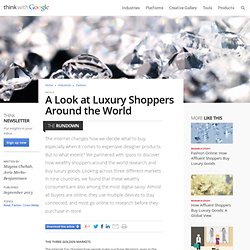
In a study conducted with Ipsos, Google discovered that the luxury fashion, jewelry and watch industries are no exception. We compared luxury buyers across nine countries and found that three different types of markets emerged. The 'new markets' of China, Brazil and Russia are luxury buyers who conduct the most research and are most reliant on digital along the path to purchase — this is important because they're also the most frequent luxury purchasers.
The 'mature markets' of the United States, Germany, England, France and Italy consult half as many sources as the new markets, but the internet still plays an important role — more than two-thirds research online before they purchase. Brand History: Goyard the World Traveller. The Goyard brand doesn’t rely on a celebrity face to help sell its products; neither does it need to advertise itself in newspapers and magazines.
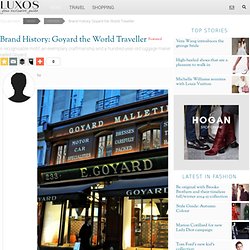
Its name alone has been enough to attract attention for over a century. With its discreet and very selective boutiques, Goyard, which was born in 1853 and has been based at 233 rue Saint Honoré ever since, has over time become one of the most famous luxury leather goods brands not only in France but also worldwide. Its stylish chevron motif is easily recognizable. We take a look at the defining moments of this business which is synonymous with success. A Family History
 In 1853, Francois Goyard, having moved from Burgundy to Paris to improve his standard of living, bought shares in the famous Morel brand, a well-established and famous trunk maker, where he worked with his son, Edmond. Their tailor-made service is simply a natural progression from the customisation that Goyard has offered its clients from the very start.
Bain WW Luxury Consumer 2014. Luxury Leaders. - 31 Jul 2013 In Conversation With Andrew Keith, President, Lane Crawford & Joyce Group Andrew Keith, President of Lane Crawford & Joyce Group, reveals how an aim to enable convenience for shoppers is uniting group strategy both on and off-lineLane Crawford and Joyce have been household names for luxury shopping in Hong Kong for decades and now China.
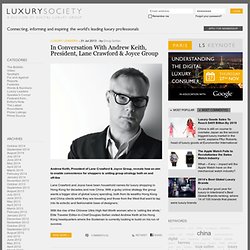
With a gutsy online strategy the group wants a bigger slice of global luxury spending, both from its wealthy Hong Kong and China clients while they are traveling and those from the West that want to tap into its eclectic and fashionable base of designers.With the rise of the Chinese Ultra High Net Worth woman who is ‘calling the shots,’ Elite Traveler Editor-in-Chief Douglas Gollan visited Andrew Keith at his Hong Kong headquarters where the Scotsman is currently looking to build on his run of success. Heterogeneous mix of 330 million consumers purchasing €217 billion in luxury goods globally, finds far-reaching new Bain & Company study.
Changing Generational Shifts and Unprecedented Fragmentation Form Rise of the ‘7 New Faces of the Global Luxury Consumer' Milan, January 14, 2014 – The number of luxury consumers worldwide has more than tripled over the past twenty years, from roughly 90 million consumers in 1995 to 330 million at the end of 2013; this according to Bain & Company, the leading advisor to the worldwide luxury goods industry, in an extensive study of 10,000 luxury consumers, conducted in collaboration with Redburn Partners, Europe's largest independent equities broker, and Millward Brown, a leading consumer research agency.

Their report, "Lens on the Worldwide Luxury Consumer," was released today at a press conference in Milan. Tourist Spending Drives Global Luxury Markets. Mall of the Emirates, Dubai International tourism and a stronger middle class are shaping luxury trends, with a focus on consumer nationality rather than geography.

Luxury consumer base to keep growing: study. Bain & Company’s 2014 annual global luxury study proclaims the rise of the consumer as luxury markets settle in for lower, but more sustainable long-term growth - Bain & Company. International tourism and a stronger middle class are shaping luxury trends, including luxury experiences and alternative luxury channels, with a focus on consumer nationality rather than geography Milan - October 14, 2014 – Slower, but steady: that is the ‘new normal’ for the global luxury market in 2014 – and potentially beyond, which is acclimating to lower, but more sustainable long-term growth.
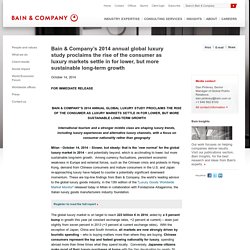
Among currency fluctuations, persistent economic weakness in Europe and external forces, such as the Crimean crisis and protests in Hong Kong, demand from Chinese consumers and mature consumers in the U.S. and Japan re-approaching luxury have helped to counter a potentially significant downward momentum. The global luxury market is on target to reach 223 billion € in 2014, aided by a 5 percent bump in growth this year (at constant exchange rates, +2 percent at current) – down just slightly from seven percent in 2013 (+3 percent at current exchange rates). Bespoke clothes take over as the real fashion luxury.
As the month-long circus of designer catwalk shows drew to an end last week, and the world's boutique buyers closed their order books with the big fashion houses of New York, London, Milan and Paris, a quiet revolution has been taking place among the style cognoscenti, who have been placing their own advance orders for their wardrobes.

The smart money is being placed on a more discerning way of buying clothes, with bespoke garments rapidly becoming the most coveted pieces. "We see so many women who have access to premium merchandise, but clients are getting more demanding and want a personal connection with their purchases," says Judd Crane, director of womenswear at Selfridges. Sales of the luxury goods industry in selected countries 2013. Reading support This statistic shows the estimated sales of the luxury goods industry in selected countries in 2013.
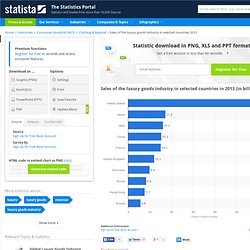
In that year, The United States' luxury goods industry was projected to have generated 62.5 billion euros. Luxury goods industry Generally speaking, garments, accessories, jewellery, watches, fragrances and cosmetics are considered to be constituent parts of the luxury market. Brand value of the leading 10 most valuable luxury brands worldwide 2014. Reading support This statistic depicts the brand value of the leading 10 most valuable luxury brands worldwide in 2014.
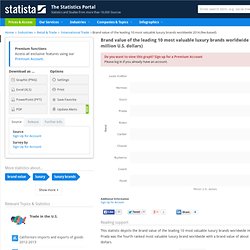
In that year, Prada was the fourth ranked most valuable luxury brand worldwide with a brand value of about 9.99 billion U.S. dollars. Moynat is Exclusively in Paris. Moynat’s gentle reawakening. In an intensively commodified world, where nothing is valued until it has been monetised and where individual Instagrammers unblushingly talk of themselves, in the third person, as brands, the hunt for the undiscovered pearl – or at least not fully leveraged pearl – has, for a certain kind of bounty hunter, become a kind of quest.
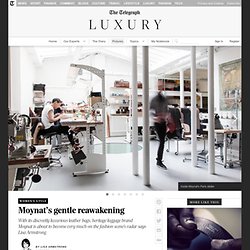
Into that category of bounty hunter must fall Bernard Arnault, who fell in love with one such pearl. For when LVMH bought Moynat, the brand was so unleveraged that it barely existed, except on paper. Moynat was founded in 1849 by two trunk makers called Octavie and Francois Coulembier who were soon joined in the venture by Pauline Moynat, the only known female luggage maker of the time. A swanky store on Avenue de l'Opéra followed. The rest is not history. Yet by the 1980s the shop had closed and the name been sold to the Scholl family. One gets the distinct impression he would like it to be his Hermès. But perhaps Nair likes torturing himself. Moynat, the Parisian Line for Those in the Know. Defining Luxury Luxury is a word that gets thrown around a lot these days.
It's used to describe anything from rustic wilderness retreats to cars. It's used by working moms when speaking of Saturday morning breakfasts with family, by authors who are able to make time to finally begin their next novel. It's used by branders and marketers to sell products, by designers to sell an image or an idea. Made for you: Prada's customised shoes and the rise of personalised fashion. If those who buy Prada shoes are already a niche, it's now possible to add even more exclusivity. In August, the Italian brand plans to launch a customisation service for its classic brogues. With 32 colours available, across the uppers and trademark foam soles, your own personal Prada shoes – complete with monogrammed initials on the bottom – are, with a payment of around £740 and wait of 60 days, within your sights.
Such an idea allows consumers to play designer – with all of those colours, it's kind of like Dulux cards for fashion. It's one that chimes with our need to regularly tweak everything from the background of our Twitter page to the milk-to-shot ratio in our morning coffee. The last word in British Luxury. The rise of discreet luxury and a new consumer elite.
There was a time when luxury was all about displaying elitism through logos and labels. Now, however, there is a shift toward consumers finding subtler ways of "showing off". Moreover, with only one in six saying they like the expensive items that they buy to feature prominent brand names, perhaps the age of logo fatigue is upon us. It became clear that it was time to sit up and take notice when that bastion of the signature motif, Louis Vuitton, ran an ad campaign in China – one of the territories frequently cited as still worshipping at the altar of upmarket bling – that carried no branding at all. The ad featured a photograph of Chinese actress Fan Bingbing drinking tea, with a pastel-coloured, logo-free LV bag at her side; the image contained no brand information. So why are we seeing a more discreet tone in the world of luxury, and what does it mean for brands in this territory if consumers are moving away from traditional status symbols?
Mulberry pays the price for failing to grasp accessible luxury. In an era when Aldi is no longer a foreign land for those used to being serviced at Waitrose and customers are no longer put off by shopping around, luxury brands are being forced to review the sweet spot between accessibility and elitism. And this is precisely where Mulberry went wrong. It was all going so well for this totem of understated and accessible luxury, known for the Alexa bag and the Del Rey bag, but Mulberry started failing when it tried to move far too upmarket. Cue lacklustre sales, a profit warning in January (its third in 18 months), the sudden departure of its yet-to-be-replace creative director Emma Hill last summer, and now the recent resignation of its CEO of two years, Bruno Guillon.
Birmingham City University - Sign In. Value of the global luxury goods market 1995-2013. Reading support This statistic shows the value of the personal luxury goods market worldwide from 1995 to 2012 and provides a forecast for 2013. In 2010, the value of the personal luxury goods market worldwide was 173 billion euros. Luxury Goods Industry The global luxury goods industry, which includes drinks, fashion, cosmetics, fragrances, watches, jewelry, luggage and handbags, has been on an upward climb for many years. Although the technical term 'luxury good' is independent of the goods' quality, they are generally considered to be goods at the highest end of the market in terms of quality and price.
LVMH (Louis Vuitton Moet Hennessy) is the most valuable luxury brand in the world, with a brand value of about 22.72 billion U.S. dollars. New markets and segments are giving the industry growth points. The Luxury Strategy: Break the Rules of Marketing to Build Luxury Brands - Jean-Noël Kapferer. Luxury Growth Weakest Since 2009 Amid Geopolitical Turmoil - BoF - The Business of Fashion. PARIS, France — Worldwide luxury-goods sales could increase this year at the slowest pace since 2009 as spending falls for the first time in China and turmoil in Hong Kong and Russia curbs tourist consumption, according to Bain & Co. Global sales of personal luxury items from handbags to watches will rise 2 percent to 223 billion euros ($282 billion), Bain estimated in a report today. That would be the weakest growth since sales fell five years ago.
Revenue will rise 5 percent when excluding currency swings, Bain said. Consumer Attitudes Towards Luxury Brands - UK - Consumer market research report - company profiles - market trends. Luxury Goods Worldwide Market Study Spring 2014 - Bain & Company. May 19, 2014 Bain study By Claudia D'Arpizio. Global luxury goods sales growth to stabilize in 2015: Bain. Luxury Goods Worldwide Market Study Winter 2014 - Bain & Company. January 14, 2014 Bain study By Claudia D'Arpizio. Explicit cookie consent. Tinker Tailor: Customize and Create Luxury Fashion.
Center for Persuasive Communication - Consumer Meaning Making: The Meaning of Luxury Brands in a Democratized Luxury World. Publication Date: Wednesday 1 May 2013 Author(s): Hudders, L.; Pandelaere, M. & Vyncke, P. Worldwide luxury goods market manages 4-6 percent revenue growth into 2014 despite regional worries, lingering weakness; according to Bain & Company’s luxury goods worldwide market study, spring 2014 update.
First quarter update of Bain's bellwether industry report shows extension of 2013 trends; exchange rate fluctuations changing purchasing patterns and flows. Traditional luxury markets benefit as China slows. Burberry Remains Digital Luxury Leader, While Céline Trails Industry - BoF - The Business of Fashion. LONDON, United Kingdom — While the impact of Burberry’s digital innovation story may be cooling as a public relations message, the British brand remains the global leader in digital luxury amidst a luxury market full of laggards, found a report released by financial services firm Exane BNP Paribas that graded leading luxury brands on their digital reach and customer experience.
Downturn for luxury goods. Redefining the Luxury Concept. How Premiumisation Has Made The Impossible Dream of Luxury Possible. World’s ‘next great pink diamond’ to go on sale. Welcome to Forbes. Global luxury goods sales to hit $405bn by 2019. Global luxury sales are expected to grow 19% to $405bn by 2019, according to market research company Euromonitor International. Emerging markets - bcu icity passport type in luxury market. Louis Vuitton launches a magazine. A Cultural Gift to Paris Could Redesign LVMH's Image - NYTimes.com. Future Trends in Luxury. Market Shift: Imported Fashion Brands Trying to Shake “Arrogant, Pretentious” Image. What will be a luxury in the future?
Is Zara The Newest Luxury Fashion Competitor? - Luxury Society - Speaker's Corner. Why The Reign of Chinese Luxury Shoppers Has Only Just Begun - Luxury Society - Speaker's Corner. Fine Jewellery: The Last True Luxury Frontier? - Luxury Society - The Bulletin. How The Uncertain Economy Is Changing The Definition Of Luxury. Luxury Goods in the United Kingdom. Explicit cookie consent. In China, Hermès Paces Itself - BoF - The Business of Fashion. The Future Of Luxury. Wiedmann07-2007.pdf. Interbrand-Best-Global-Brands-2013.pdf. Interbrand-Best-Retail-Brands-2014-3.pdf. What are luxury goods? definition and meaning. Youtube.
The Multi-Facets of Luxury Retailing - Luxury Society - Speaker's Corner. Is luxury history? 14 March 2013 - Global - Imagination. The New Luxury is Luxury For All, Suggests Jean-Noël Kapferer - Luxury Society - Spotlight. Lcca.org. Four Ways Burberry is Pushing the Boundaries of Luxury Retailing. Type into google luxury fashion demographics. Middle market: Second-tier brands tap into straitened times. Marc Jacobs at New York fashion week: army fatigues with a luxury edge. Coco Chanel quote. Why High-End Luxury Brands Are Losing Their Luster. Luxury Sales to Exceed $318 Billion, Driven by Emerging Markets and ‘Affordable Luxury’ 5 Trends That Defined The Luxury Industry in 2013 - Luxury Society - Editor's Note. Luxury brands battle to stay in fashion in South Korea. Luxury sales 2013 source: Financial times article. Y-3 (Yohji Yamamoto x adidas) Retailer/Designer Collaborations. Designer collaboration - theFashionSpot. The Top 20 Designer Collaborations: A Timeline - Fashionista.
15 Most Shoppable Designer Collaborations. Louis Vuitton steps up accessories revamp with new designer. Rethinking Luxury's Democratic Dilemma - Luxury Society - Speaker's Corner. Luxury 2020: 3 Trends Reshaping The Luxury Market. The World’s Ten Most Powerful Luxury Brands: 2011 Edition. The Age of Fashion Massclusivity.
In Depth Look Into The New Luxury Market Marketing Essay.